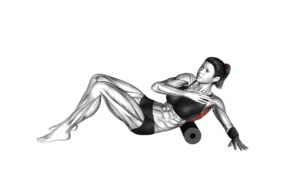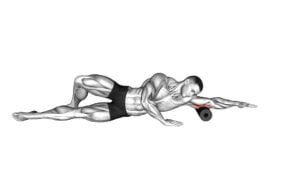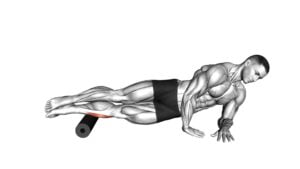Roll Lower Back (Side) Lying on Floor – Video Exercise Guide & Tips

Are you looking for a simple and effective exercise to strengthen your lower back? Look no further!
Watch This Exercise Video
In this video exercise guide, we'll show you how to perform the Roll Lower Back (Side) Lying on Floor. By following the proper form and technique, you can reap the benefits of this exercise, such as improved core stability and reduced back pain.
Get ready to roll your way to a stronger back with our helpful tips and instructional video. Let's get started!
Key Takeaways
- The Roll Lower Back exercise improves flexibility and strengthens core muscles.
- It targets muscles in the lower back and enhances range of motion in that area.
- The exercise helps with everyday activities like bending and twisting.
- Proper form and technique, as well as modifications and progressions, are important to avoid injuries and maximize the benefits of the exercise.
Benefits of the Roll Lower Back Exercise
To understand the benefits of the Roll Lower Back Exercise, you need to know that it can help improve flexibility and strengthen your core.
This exercise specifically targets the muscles in your lower back, which play a crucial role in maintaining proper posture and supporting your spine. By regularly performing the Roll Lower Back Exercise, you can increase the range of motion in your lower back, making everyday activities such as bending and twisting easier and more comfortable.
In addition to improving flexibility, this exercise also works to strengthen your core muscles. Your core is made up of the muscles in your abdomen, lower back, and pelvis, and it acts as a stabilizer for your entire body. By engaging these muscles during the Roll Lower Back Exercise, you can enhance their strength and stability. A strong core not only improves your overall balance and stability, but it also helps to prevent injuries and reduces the risk of lower back pain.
Now that you understand the benefits of the Roll Lower Back Exercise, it's important to learn the proper form and technique. By maintaining proper alignment and engaging the correct muscles, you can maximize the effectiveness of this exercise and avoid potential injuries.
Proper Form and Technique
To perform the Roll Lower Back Exercise with proper form and technique, you should lie on the floor on your side. Start by lying on your side with your knees bent and your legs stacked on top of each other. Place your bottom arm straight out in front of you, with your palm facing downwards. Keep your head aligned with your spine and your neck relaxed.
One common misconception about this exercise is that you need to forcefully roll your lower back. However, the key is to initiate the movement from your core muscles, specifically your obliques. Engage your core and slowly roll your hips towards the floor, allowing your lower back to naturally follow. As you roll, keep your legs and feet together and maintain a straight line from your head to your hips.
If you find it difficult to perform the Roll Lower Back Exercise on the floor, there are alternative exercises you can try. One option is to perform the exercise on a stability ball, which can provide additional support and help improve balance. Another alternative is to use a foam roller, placing it under your side and rolling back and forth to target the muscles in your lower back.
Now that you understand the proper form and technique for the Roll Lower Back Exercise, let's move on to discussing modifications and progressions that can help you further challenge your core muscles.
Modifications and Progressions
To modify or progress the Roll Lower Back Exercise, you can use additional equipment or increase the difficulty level.
Modifications can be made by using a foam roller or a yoga block to provide support and stability. Placing the foam roller or yoga block under your side can help you maintain proper alignment and make the exercise more accessible. This modification is particularly helpful for beginners or individuals with limited mobility.
Another way to modify the exercise is by reducing the range of motion. Instead of rolling your entire lower back, you can start by rolling only a small portion of your back. This allows you to gradually build strength and flexibility before progressing to the full range of motion.
On the other hand, if you want to increase the difficulty level of the exercise, you can try performing the roll on an unstable surface. This could be a stability ball or a balance board, which challenges your core stability and engages more muscles during the movement.
Remember to listen to your body and choose modifications or variations that suit your fitness level. It's important to maintain proper form and technique to avoid any potential injuries.
Incorporating these modifications and variations can help you progress in your fitness journey and continue challenging your body.
Common Mistakes to Avoid
You should avoid these common mistakes when performing the Roll Lower Back (Side) exercise to ensure you're maximizing the benefits and avoiding injury.
First and foremost, it's important to maintain proper alignment throughout the exercise. Avoid arching or rounding your back excessively, as this can put unnecessary strain on your spine. Instead, focus on keeping your spine neutral and engaging your core muscles to support your movements.
Another common mistake to avoid is using momentum to roll from one side to the other. This can diminish the effectiveness of the exercise and increase the risk of injury. Instead, move slowly and deliberately, using your core muscles to control the movement.
Furthermore, it's important to avoid lifting your shoulders off the ground during the exercise. This can strain your neck and shoulders and take away from the targeted work on your lower back. Keep your shoulders relaxed and grounded throughout the movement.
Lastly, make sure to breathe properly during the exercise. Holding your breath can increase tension in your muscles and make the exercise more difficult. Take deep breaths in and out throughout the movement to maintain relaxation and control.
Tips for a Safe and Effective Workout
Ensure a safe and effective workout by incorporating these key tips.
First and foremost, it's important to have the essential equipment for your workout. Depending on the exercise, this may include items such as dumbbells, resistance bands, or a yoga mat. Having the right equipment won't only enhance your workout but also help prevent injuries.
Before diving into your workout, always start with a proper warm-up routine. This is crucial to prepare your body for the physical demands of the workout ahead. A warm-up can consist of dynamic stretches, light cardio exercises, or foam rolling. By increasing your heart rate and loosening up your muscles, you can reduce the risk of strains or sprains during your workout.
During your workout, it's vital to listen to your body. Pay attention to any discomfort or pain and adjust your movements accordingly. Pushing through pain can lead to serious injuries, so always prioritize your safety. Additionally, maintain proper form throughout each exercise. This ensures that you're targeting the intended muscles and reducing the risk of injury.
Remember to stay hydrated and take breaks as needed. Overexertion can lead to fatigue, dizziness, or even fainting. By staying hydrated and taking regular breaks, you can maintain your energy levels and perform at your best.
Frequently Asked Questions
How Many Repetitions of the Roll Lower Back Exercise Should I Do?
To determine how many repetitions of the roll lower back exercise you should do, it's important to consider your fitness level and goals.
Beginners may want to start with 8-10 repetitions and gradually increase as they become more comfortable and stronger.
It's always a good idea to listen to your body and stop if you feel any pain or discomfort.
Remember to modify the exercise if needed and avoid common mistakes like using momentum or straining your neck.
Can I Perform the Roll Lower Back Exercise if I Have a Pre-Existing Lower Back Injury?
If you have a pre-existing lower back injury, it's important to consult with a healthcare professional before attempting the roll lower back exercise. They can assess your condition and determine if it's safe for you to perform this exercise.
Keep in mind that certain movements involved in the exercise may aggravate your injury, so it's crucial to prioritize your safety and well-being.
Always prioritize proper form and listen to your body when engaging in any exercise routine.
Is It Necessary to Warm up Before Doing the Roll Lower Back Exercise?
Before performing the roll lower back exercise, warming up is highly recommended. Warming up helps prepare your muscles and joints for the movement, reducing the risk of injury. It increases blood flow and flexibility, allowing for better range of motion.
However, if you're unable to warm up, there are alternative exercises you can try that target the same muscle groups.
Can I Use a Foam Roller Instead of Lying on the Floor for the Roll Lower Back Exercise?
Yes, you can use a foam roller instead of lying on the floor for the roll lower back exercise.
However, keep in mind that the floor lying position offers certain benefits such as stability and support.
Using a foam roller may provide a different level of challenge and engage additional muscles.
It's important to choose the option that suits your fitness level and goals.
Are There Any Specific Breathing Techniques I Should Follow During the Roll Lower Back Exercise?
During the roll lower back exercise, it's important to focus on your breathing techniques. By taking deep breaths in and exhaling fully, you can enhance the benefits of this exercise.
Proper breathing helps to relax your muscles and improve your range of motion. It also promotes better oxygen flow to your body, aiding in the release of tension and stress.
Conclusion
Incorporating the roll lower back exercise into your workout routine can provide numerous benefits, including improved core strength and flexibility. By following proper form and technique, you can enhance the effectiveness of this exercise.
Additionally, modifications and progressions can be made to tailor the exercise to your fitness level. Avoiding common mistakes and following safety tips will help ensure a safe and effective workout.
By incorporating the roll lower back exercise into your fitness regimen, you can achieve a stronger and more resilient lower back.

Author
Years ago, the spark of my life’s passion ignited in my mind the moment I stepped into the local gym for the first time. The inaugural bead of perspiration, the initial endeavor, the very first surge of endorphins, and a sense of pride that washed over me post-workout marked the beginning of my deep-seated interest in strength sports, fitness, and sports nutrition. This very curiosity blossomed rapidly into a profound fascination, propelling me to earn a Master’s degree in Physical Education from the Academy of Physical Education in Krakow, followed by a Sports Manager diploma from the Jagiellonian University. My journey of growth led me to gain more specialized qualifications, such as being a certified personal trainer with a focus on sports dietetics, a lifeguard, and an instructor for wellness and corrective gymnastics. Theoretical knowledge paired seamlessly with practical experience, reinforcing my belief that the transformation of individuals under my guidance was also a reflection of my personal growth. This belief holds true even today. Each day, I strive to push the boundaries and explore new realms. These realms gently elevate me to greater heights. The unique combination of passion for my field and the continuous quest for growth fuels my drive to break new ground.







